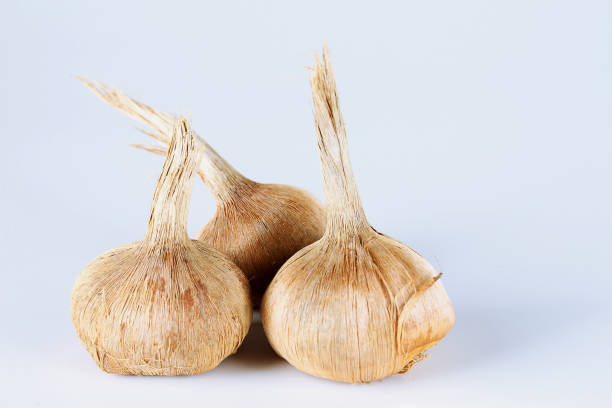Saffron Bulbs: Types and Importance
Saffron bulbs, this precious and hidden treasure beneath the soil, are one of nature’s wonders that conceal their secrets within the earth. As you may know, various types of saffron bulbs have been introduced to the market, each with its own unique features and characteristics.
What is a Saffron Bulb?
The saffron bulb, which is essentially a plant rhizome, constitutes the underground part of the saffron plant. This part of the plant, about the size of a walnut and with a smooth, shiny skin, is responsible for storing nutrients and regenerating the plant during growth periods. Saffron bulbs enable the cultivation and production of valuable saffron flowers and are considered one of the most important elements in the saffron industry.
Saffron bulbs typically produce flowering stems each year, leading to the production of saffron with high commercial value. These bulbs yield the best results in rich, fertile soils, and depending on climatic conditions and soil type, they will have varying outputs. The best time to plant them is from mid-June to September.
Types of Saffron Bulbs
In the world of saffron bulbs, each type represents a specific region of the globe where they have formed in different lands. Iranian saffron bulbs, which grow in the vast plains and fertile soils of Iran, are of high quality due to special climatic conditions and the knowledge and experience of Iranian farmers. Saffron bulbs are classified into different grades based on size and age.
Saffron Bulbs for Greenhouse Cultivation (Soilless)
In this method, farmers separate saffron bulbs from the soil in June after the grass has turned yellow and keep them in a cool environment. In early September, bulbs weighing over 10 grams are placed in wooden trays and moved to the greenhouse. The conditions for temperature, light, and humidity are then adjusted to ensure optimal growth.
Saffron Bulbs Based on Weight
Larger bulbs are used for greenhouse cultivation, while smaller and medium-sized bulbs are used for soil planting, as their yield increases in subsequent years.
Saffron Bulbs Based on Cultivation Region
The planting of saffron bulbs is divided into two categories based on the growth area:
– Cold Regions: The best time to plant saffron bulbs in these areas is before the onset of autumn rains.
– Tropical Regions: In these areas, saffron planting occurs later since the weather cools down later, and suitable conditions for plant growth take longer to establish.
Traditional or Soil-Based Saffron Bulbs
This method is the most common and oldest method of saffron cultivation, where bulbs are planted manually or using machinery in the soil. These bulbs weigh between 3 to 15 grams and are suitable for traditional cultivation.
Greenhouse Saffron Bulbs
This method is a smart approach to saffron cultivation, where the farmer creates a controllable environment to harvest high-quality saffron. These bulbs typically weigh over 12 grams, with some weighing between 40 to 50 grams. This type of cultivation is done using hydroponic and aeroponic methods.
Important Tips for Buying and Cultivating Saffron Bulbs
When purchasing saffron bulbs, it is essential to ensure that the bulbs are physically healthy and free from any signs of rot, mold, or pests. Heavier bulbs generally indicate greater age and capacity for producing more flowers.
In the planting process, attention should be paid to factors such as selecting the right soil, optimal planting temperature, planting depth, row spacing, appropriate irrigation, pest and disease management, summer rest periods, adequate nutrition, and bulb processing. Adhering to these considerations can guarantee your success in producing a quality and profitable crop.
Final Thoughts
In saffron agriculture, selecting the type of saffron bulb for planting is one of the critical steps that significantly impacts the quality of the final product. When purchasing saffron bulbs, attention should be paid to important factors such as price, availability, production goals, and compatibility with the region’s climatic conditions.



